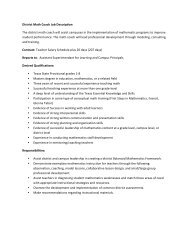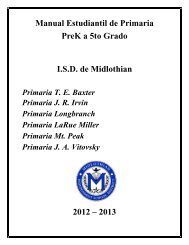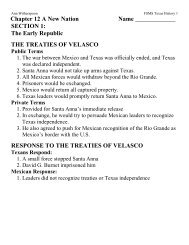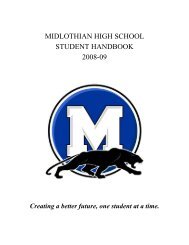AP Biology 2013 Summer Assignment .pdf - Midlothian ISD
AP Biology 2013 Summer Assignment .pdf - Midlothian ISD
AP Biology 2013 Summer Assignment .pdf - Midlothian ISD
Create successful ePaper yourself
Turn your PDF publications into a flip-book with our unique Google optimized e-Paper software.
ASSIGNMENT # 2 BIOLOGY COLLECTION For this part of your summer assignment, you will be familiarizing yourself with science terms that we will be using at different points throughout the year. 1. Each item is worth 2 points. You must earn 100 points by Friday August 31. 2. Earn 100 points by “collecting” 50 items from the list of terms. When I say “collect”, I mean you should collect that item by finding it and taking a photograph (digital or paper printed) of the item. You will post your ‘photographs’ in an electronic file (powerpoint or otherwise) along with the definition of the word you have chosen and email it to my address before the due date. 3. YOU CAN BE CREATIVE: If you choose an item that is internal to a plant or animal, like the term “phloem”, you cannot submit a photograph of the whole organism. You can, however, submit a close up of one part, and then explain under the photo what phloem is and specifically where phloem is in your specimen. 4. NATURAL ITEMS ONLY: All items must be from something that you have found or normally see in nature. Take a walk around your yard, neighborhood, and town. DON’T SPEND ANY MONEY! Research what the term means and in what organisms it can be found... and then go out (or in) and find an example. BIOLOGY COLLECTION TERMS Below are the items you are to “collect”. An individual organism can only be used once. Humans are acceptable for one category only. Each specimen is worth 2 points. You may only have 1 example of each item; submitting more than 1 will not add any additional points. adaptation of a plant adaptation of an animal allopatric isolation altruistic behavior amniotic egg analogous structure angiosperm anther & filament of a stamen archeabaceria asexual reproduction ATP autotroph auxin Batesian mimicry bilateral symmetry biological magnification bryophyte C3 Plant C4 Plant CAM Plant cellular respiration cline coevolution commensalism counter current exchange detrivore directional selection disruptive selection dominant phenotype ectotherm endotherm enzyme epistasis epithelial tissue ethylene eubacteria eukaryote fermentation gametophyte gibberellins glycogen GMO genetically modified organism gymnosperm heterotroph homeostasis homologous structures hydrophilic hydrophobic K-‐strategist (K-‐selected species) keystone species kinesis (insect or animal) lipid Mullerian mimicry mutualism mycelium mycorrhizae niche parasitism pleiotropy population predation primary succession prokaryote r-‐strategist (r-‐selected species) radial symmetry (animal) rhizome secondary succession sporophyte stabilizing selection sympatric isolation taxis territorial behavior tropism vestigial structures











![Course Catalog [PDF] - Midlothian ISD](https://img.yumpu.com/36431290/1/190x245/course-catalog-pdf-midlothian-isd.jpg?quality=85)




